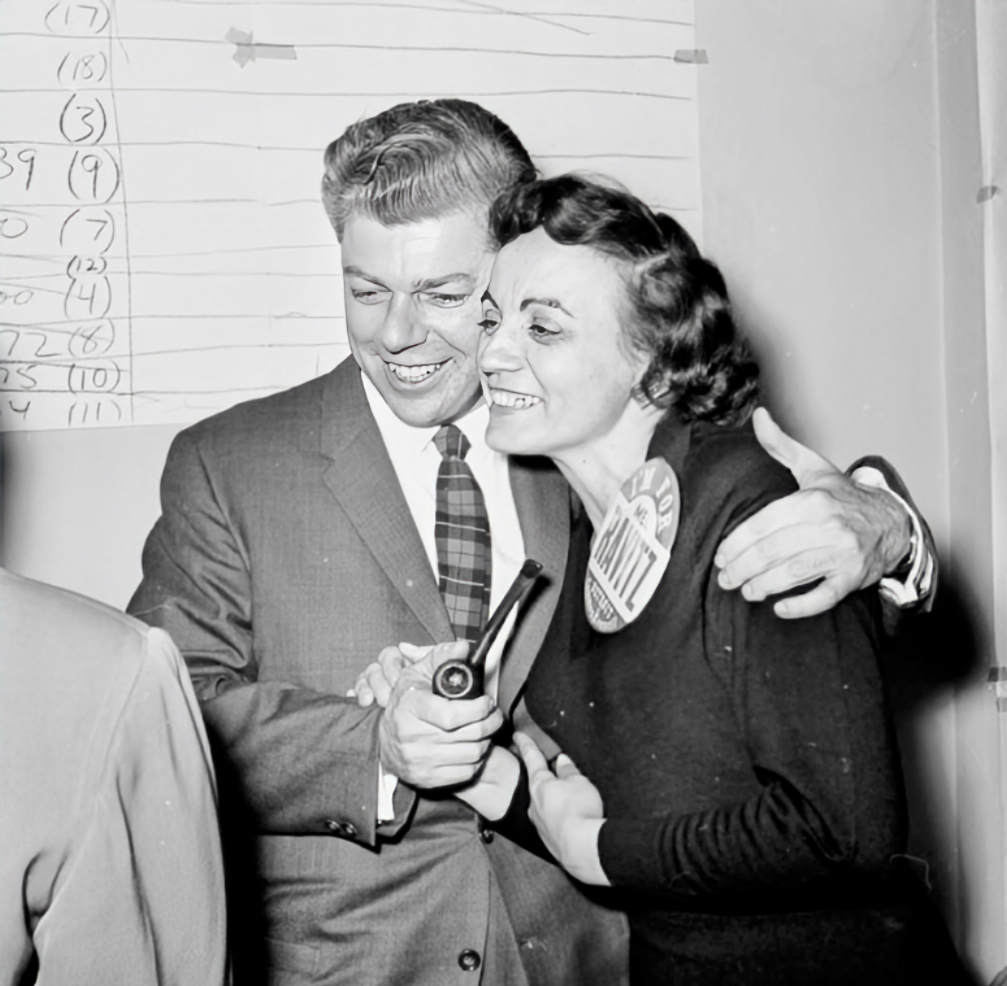Third Man: Mel Ravitz and Detroit’s Election of 1973

This past November marked 50 years since the historic Detroit election of 1973, when Coleman Young edged out police chief John Nichols to become the first Black mayor of the Motor City.
Young’s victory, which rode a wave of growing anger at the conduct of the Detroit police, is rightly remembered as a watershed moment for the embattled metropolis.
What’s less often remembered is that there was a third man in the mayoral contest that year: a Jewish candidate, Mel Ravitz.
Even less often remembered is that many observers initially favored Ravitz to win that crucial election.
From Planning to Politics
Congregation Beth David, on 14th and Elmhurst, where Mel Ravitz was raised. (Shtetlhood.com)
Mel Ravitz had been born in New York, but in other respects he was a native son of Detroit’s Jewish community. He attended Central High School, graduated Wayne University with a history degree, and worked briefly as a radio host for WDET, a station then owned by the newborn United Auto Workers.
Coming of age in the years of the Great Depression and World War Two must have influenced Ravitz’s later politics, including his concern for the underdog. In the fight against fascism, many Jews at the time embraced left-wing politics. Half of Ravitz’s friend group, he later noted, had voted Socialist in the election of 1948. Yet Ravitz’s initial path led him towards academia. Ravitz earned a master’s in sociology from the New School in New York and went on for a PhD at the University of Michigan.
As it turned out, U-M policy helped nudge Ravitz towards public service. U-M did not allow PhD students to teach full time before completing their dissertations, so instead of returning to Wayne State, while completing his thesis Ravitz went to work as an urban planner for the City of Detroit. His focus was on the “Mack-Concord” area of Detroit’s near east side, roughly corresponding to what is now known as Charlevoix Village or Islandview.
At the time, the trend in urban planning was to improve conditions in inner cities by demolishing them, a trend many of Detroit’s city planners embraced. Ravitz’s sociological training and sensitivity predisposed him to a different approach, called “neighborhood conservation,” and towards working with people to build relationships to advance the common good.
In the early 1950s, the Mack-Concord area, like many other Detroit neighborhoods, was undergoing a rapid racial transition: in its case, from mostly Italian to mostly Black. Ravitz and his colleagues went to work there more or less as community organizers. They forged ties between neighborhood residents by organizing block clubs, street fairs and even a community newspaper, as well as helping neighborhood residents secure more city investment for parks, code enforcement and traffic calming.
But the Mack-Concord program became a victim of its own success. After City Hall was inundated with letters and petitions from residents, Mayor Miriani got wind of the fact that his own staff had helped to instigate them, and had Ravitz and friends transferred to a different department. Ravitz quit not long afterwards—and launched a successful campaign for Detroit’s Common Council.
An Idealist in City Hall
Mel Ravitz (second from right) on Detroit Common Council in the early 1960s. (Wayne State University Virtual Motor City Collection)
Putting his principles into practice in office, however, proved difficult. When Ravitz was elected to Council in 1961, that body was elected entirely at-large, instead of from individual districts. The system worked to disenfranchise the city’s growing Black minority, much as gerrymandering does in many states today.
Ravitz worked with the lone Black council member, Bill Patrick, to pass a Fair Housing Ordinance that would ban discrimination and prevent the block-busting tactics of the real estate industry. Ultimately, however, the pair could only muster the votes for a watered-down version of the measure. They also met vigorous and, at times, violent resistance. Ravitz’s daughter recalled that the family had their car’s tires slashed and bricks thrown through their windshield on a regular basis.
Ravitz never shed his academic eccentricities. Known to City Hall reporters as “the Professor,” he wore horn-rimmed glasses and was frequently seen clutching his pipe. When discussions got especially heated, he’d begin to blow smoke rings across the room. Still, Ravitz struck many observers as a surprisingly effective member of Council. In the wake of the 1967 rebellion, Ravitz also struck many people as one of the few elected officials trusted by both white and Black residents alike.
Ravitz urged the region’s white majority not to turn their backs on Detroit, insisting that addressing the inequalities that produced the rebellion was ultimately in their own best interest. “Suburbia is no sanctuary,” he said. “Separatism spells ultimate disaster…Either we concern ourselves now with the plight of every part of the region, or we reconcile ourselves to piecemeal deterioration.”
It was not a message that everyone wanted to hear.
The Election of 1973
Mel Ravitz (second from right) and Coleman Young at a 1973 mayoral debate. (Wayne State University Virtual Motor City Collection)
In 1973, Ravitz ran for Mayor of Detroit. As a longtime City Council member who could draw votes from the growing Black community and the white majority, he was initially favored to win, or at least to make it to the runoff election against the hard-line conservative candidate, police chief John Nichols.
Instead, he came in third, behind Nichols and former state legislator Coleman Young, whose campaign against police brutality had energized the Black grassroots.
As the Free Press opined in a postmortem on his campaign, “Ravitz appealed to voters everywhere, but not enough anywhere…he appeared to have been defeated by the same racial divisions that he had worked for years to break down.” Another way of putting it would be to say that Detroit’s Black community was ready to elect one of its own.
What’s often overlooked is that if not for the presence of another “white liberal” candidate, John Mogk, Ravitz might well have made it through the primary and went on to win the general election to become Detroit’s first Jewish mayor.
At least, that was Ravitz’s opinion, according to Mogk himself, now a professor of law at Wayne State. If Mogk’s voters had supported Ravitz, Ravitz would have outpolled Young, putting him on track to take on Nichols in November.
We’ll never know if that would have happened, of course. It’s tempting to speculate that if Ravitz had been elected Mayor, the city’s trajectory would have been somehow different. But that’s unlikely.
As Thomas Sugrue wrote in his history of postwar Detroit, The Origins of the Urban Crisis, “by the time Young was inaugurated, the forces of economic decay and racial animosity were far too powerful for a single elected official to stem.”
Denouement
Elder statesman: Mel Ravitz in his later years. (Wayne State University Virtual Motor City Collection)
Ravitz’s defeat in 1973 must have come as a blow, but he did not retire from politics as a result. He took a job as director of the new Detroit-Wayne County Community Mental Health Services Board, the ancestor of today’s Detroit-Wayne County Integrated Health Network, and eventually won reelection to City Council in 1982.
In four additional terms on Council, Ravitz was a strong critic of subsidies for downtown development and projects like the General Motors Poletown plant, which yielded marginal economic benefits while displacing thousands of residents. He also continued to teach in the Wayne State urban studies and planning program.
Ravitz ultimately retired from Council in 1997. He died in 2010, as the Great Recession, subprime mortgage crisis and near-collapse of the automobile industry devastated Detroit.
As Ravitz observed a half-century ago, the fate of Detroit and other cities is in no way accidental. “Urban pattern,” he said, “follows power,” and changing the relations of power, as he attempted to do in Detroit, might yield a better and more humane city.
This holiday season, in these difficult times for our nation and world, we might do well to remember the example of Mel Ravitz, and struggle not just for our own liberation, but for the liberation of all.
Joel Batterman works for Transportation Riders United and is a board member of Detroit Jews for Justice.
Mel Ravitz and his wife Eleanor celebrate his election to City Council. (Wayne State University Virtual Motor City Collection)
